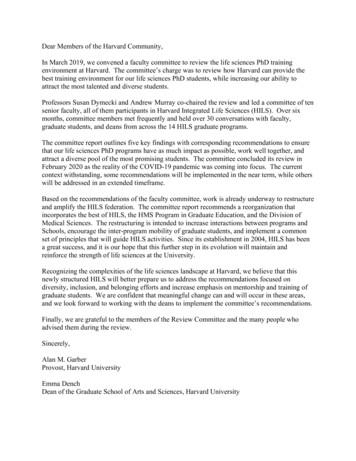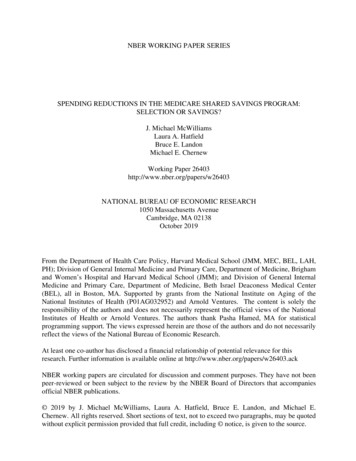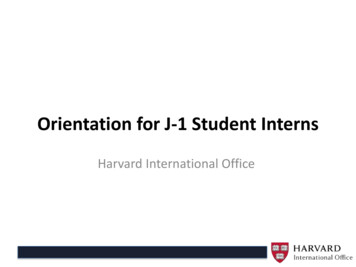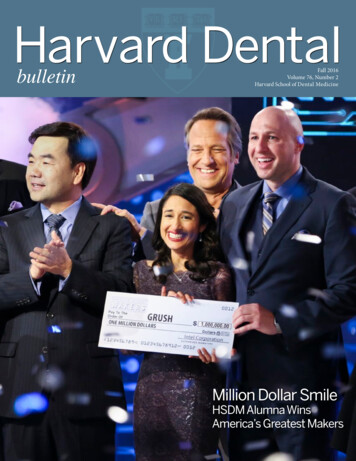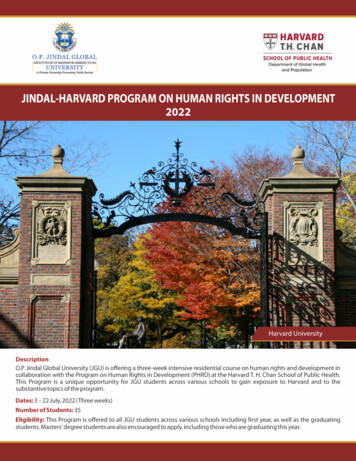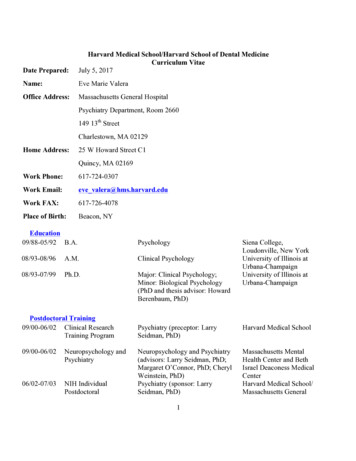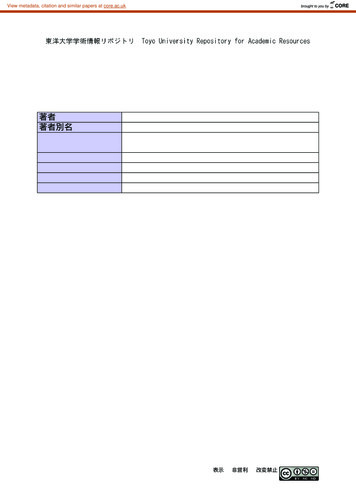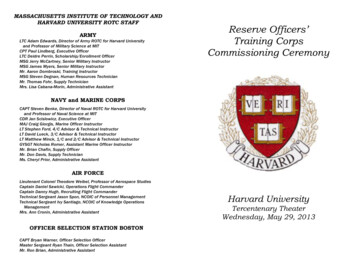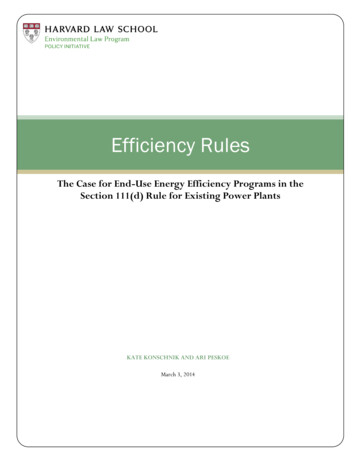
Transcription
Efficiency RulesThe Case for End-Use Energy Efficiency Programs in theSection 111(d) Rule for Existing Power PlantsKATE KONSCHNIK AND ARI PESKOEMarch 3, 2014
Efficiency RulesThe Case for End-Use Energy Efficiency Programs in theSection 111(d) Rule for Existing Power PlantsExecutive SummaryRobust discussions are underway about EPA’s options for crafting greenhouse gasemission guidelines for existing power plants. The discussions reflect widespreadagreement that end-use energy efficiency is a cost-effective method for reducinggreenhouse gas emissions. Yet stakeholders diverge on the role energy efficiencyprograms should play in the guidelines.The Clean Air Act authorizes greenhouse gas performance standards for existing powerplants based on emission reductions achievable across the power sector. Therefore, enduse energy efficiency may be considered an eligible system of emission reduction.Moreover, EPA must set emission guidelines based on the “best system of emissionreduction” that has been “adequately demonstrated,” and must tighten standards when“emission limitations and percent reductions beyond those required by the standards . . .are achieved in practice.” These statutory directives establish the “symmetry principle:”any adequately demonstrated system of emission reduction available for compliance with aperformance standard must also drive the standard’s stringency.Efficiency Rules 3/3/2014End-use energy efficiency programs have been adequately demonstrated as cost-effective methods for achievingenergy savings and reducing air pollution. Stakeholders support these programs to comply with performancestandards. Under the symmetry principle, EPA must then account for achievable emission reductions from end-useenergy efficiency programs in setting the stringency of its emission guidelines for existing power plants.1Stakeholders also debate the existence of reliable protocols for measuring and verifying emission reductions fromenergy efficiency. Over the last 30 years, the Department of Energy (DOE), States, electric utilities, energy servicecontractors, and regional grid operators have developed methods for measuring energy savings from energy efficiencyprograms. Parties rely on these methods to enforce energy efficiency mandates, to calculate utility rates, incentives,and energy service contract compensation, and to maintain reliability of the electric grid. EPA has developedmethods for converting energy savings from energy efficiency into emission reductions, and States have used thesemechanisms to demonstrate compliance with Clean Air Act requirements. EPA should reference established energyefficiency measurement and verification protocols when setting minimum standards in its power plant guidelines.
Efficiency RulesThe Case for End-Use Energy Efficiency Programs in theSection 111(d) Rule for Existing Power PlantsEPA has proposed New Source Performance Standards (NSPS) for cutting greenhouse gas (GHG) emissions fromnew fossil-fuel burning power plants.1 In parallel or directly following promulgation of new source standards,Section 111(d) of the Clean Air Act directs EPA to issue guidelines for States to follow when implementingperformance standards from existing power plants.2Existing power plant guidelines could drive significant GHG reductions in the electricity sector.3 However, due tothe relatively small universe of pollutants covered by Section 111(d), EPA has triggered this provision infrequently.Therefore, EPA has not explored the full potential of options for setting an existing source standard, and courts haveset no boundaries in this regard. This paper discusses the flexible contours of Section 111(d) and establishes thepotential for end-use energy efficiency (EE) programs to drive existing source guidelines and meet the correspondingperformance standards.IntroductionGiven the flexible contoursof Section 111(d), EPAcould consider achievableemission reductions fromend-use energy efficiency(EE) programs to driveexisting source guidelinesand authorize their use tomeet the correspondingperformance standards.Stakeholders diverge, however, on EE’s precise role. Someorganizations urge EPA to include these programs as part of the“best system of emission reduction” (BSER) for power plants, andtherefore for EE to drive the stringency of the performancestandard.7 Other organizations argue that performance standardsshould be based on a narrower universe – what reductions areachievable within the fence line of an emitting source – but that EEshould be available as an equivalent means of complying with that standard.8 One industry group, the NationalClimate Coalition (NCC), acknowledges that EE programs could be part of the BSER, if they “develop to the pointwhere they offer a consistent, adequately demonstrated and cost-effective compliance pathway.”9 Until then, theNCC believes EE should only be used for crediting avoided emissions to generators.10Efficiency Rules 3/3/2014Robust discussions are underway about EPA’s options for craftingGHG guidelines for existing plants.4 These discussions reflectwidespread agreement that EE is a cost-effective method forreducing GHGs.5 States, industry, and environmental groups alikehave asked EPA to consider incorporating these types of programsinto the Agency’s power plant guidelines.62
If serious questions did exist about EE, it would be inappropriate to rely on these programs for compliance.However, this paper argues that EE is an adequately demonstrated method for achieving cost-effective GHG emissionreductions. The results of EE programs are consistent enough for grid operators, states, utilities, and energy servicecompanies to rely on them for many financial and legal purposes. EE’s well-established reliability supports its use forcompliance purposes and qualifies EE as part of the BSER. Regardless of the form EPA’s emission guidelines take, theAgency would be on solid legal footing to set their stringency based in part on EE’s demonstrated ability to achieveemissions reductions.Section 111(d) Authorizes EPA to Define a Best System of EmissionReductions for the Power SectorSection 111(d): Legal FrameworkSection 111(b) of the Clean Air Act directs EPA to publish a list of categories of stationary sources that in theAgency’s judgment, “cause[ ], or contribute[ ] significantly to, air pollution which may reasonably be anticipated toendanger public health or welfare.”11 EPA sets standards of performance for new sources in each category.12 UnderSection 111(d), EPA issues emission guidelines for existing sources in the same category;13 States then implementperformance standards that are “no less stringent than the corresponding emission guideline(s).”14Some have argued that Section 111 requires all emission reduction measures to occur due to action taken at asource.15 However, the language of the statute does not support this contention. The heart of the Section 111program is the standard of performance, defined in Section 111 as:a standard for emissions of air pollutants which reflects the degree of emission limitation achievable through theapplication of the best system of emission reduction which (taking into account the cost of achieving suchreduction and any nonair quality health and environmental impact and energy requirements) the Administratordetermines has been adequately demonstrated.16Efficiency Rules 3/3/2014This definition does not limit EPA’s consideration of emission reduction systems to those that are implemented at asource or facility. To the contrary, the breadth of the “best system of emission reduction” and the fact that the CleanAir Act provides no definition for this term implies a broad delegation of authority, providing EPA with flexibility insetting and approving performance standards. The definition’s multi-factor balancing test provides some guidance,while enabling the Agency and the States to craft cost-effective standards that make sense for each source category.3The rest of Section 111 likewise supports EPA’s broad inquiry into “adequately demonstrated” systems. There is nolanguage requiring the performance standard to be achieved at each source. Section 111(b) directs EPA to setstandards of performance “for new sources”;17 Section 111(d) requires states to “establish[ ] standards of performancefor any existing source”.18 These provisions do not constrain the setting of performance standards to systems ofemission reduction occurring within the source’s fence line.Section 111(d) goes further in supporting consideration of all “systems of emission reduction” across a category ofexisting sources. First, when describing the process for setting existing source standards, Section 111(d) references
Section 110,* which contemplates the use of “economic incentives such as fees, marketable permits, and auctions ofemissions rights.”19 Under Section 110, EPA and the States previously established a “beyond the fence line” pollutiontrading programs to limit smog and soot from power plants.20 By referencing Section 110, Section 111(d)incorporates its list of approved measures for emissions reductions, including market-based, system-wide programs.21Second, Section 111(d) authorizes EPA and the States to consider “other factors” when establishing existing sourceguidelines and standards.22 Here, “other factors” should include the pollutants and the source category at issue.GHGs are ubiquitous and well-mixed in the atmosphere. Pollution trading programs can lead to “hot spots” ofpollution, particularly with pollutants that have strong localized effects, such as soot or heavy metals. This is not aconcern with GHGs,23 making them particularly amenable to category-wide emission reduction approaches.In addition, electric generating units are more integrated than other source categories regulated by the EPA. Theelectricity grid is a system of interconnected generators and consumers, operated on a regional basis.24 Gridoperators** generally dispatch generating facilities tomeet demand in a cost-effective way. If a generator isEPA has issued Section 111(d)unavailable or demand increases, the system operatorguidelines based on systems ofcalls on other facilities to operate or increase output toemission reduction beyond themake up for the shortfall. Similarly, when demanddecreases, a system operator will order facilities to shutfence line of each source.down or reduce their output. This integration supportsSpecifically, EPA has authorizedconsideration of the entire system when settingpollution trading among sourcesperformance standards.in two Section 111(d) rules.In sum, the statute provides significant discretion toEPA, while setting forth a multi-factor analysis that requires EPA to evaluate cost, energy requirements, and healthand environmental benefits to arrive at the best system of emission reductions. By relying on this test, incorporatingSection 110 by reference, and enabling consideration of “other factors,” Section 111(d) authorizes EPA to considermeasures that reduce emissions from the source category, whether they are implemented within or beyond the fenceline of any particular source.EPA’s Previous 111(d) RegulationsIn 1975, EPA issued general rules governing the submission and review of State’s Section 111(d) plans.25 EPA has alsoissued health-based*** guidelines under Section 111(d) for eight types of existing sources: landfills; municipal wasteSome have argued that the reference to Section 110 in 111(d)(1) is intended to establish a process only and does not incorporateSection 110’s substantive requirements. See HUNTON & WILLIAMS, supra note 4, at 3-4. However, the procedure set forth inSection 110 requires State plans to include all substantive provisions that are “necessary or appropriate to meet the applicablerequirements” of the Clean Air Act, 42 U.S.C. § 7410(a), and directs EPA to set substantive criteria, review State plans forcompliance with those criteria, and disapprove non-compliant portions, 42 U.S.C. § 7410(k). Thus, the substantive provisions inSection 110 are embedded in and inextricably linked with the procedure.**Grid operators are responsible for balancing supply of electricity from generators with consumer demand for power acrosstheir regional territories. Operators instruct generators how much to produce and ensure that the system has adequate reservesavailable. Grid operators include independent entities, such as PJM, private utilities, and Federal government entities.***EPA’s rules establish a less formal process for Section 111(d) guidelines relating to welfare-based pollutants. See 40 C.F.R. §60.22(d)(1). EPA has issued welfare-based guidelines for fluoride emitted from phosphate fertilizer plants and primaryaluminum plants, and total reduced sulphur emitted from kraft pulp mills.Efficiency Rules 3/3/2014*4
combustors; two other categories of commercial and industrial solid waste incinerators; sulfuric acid plants; medicalwaste incinerators; sewage sludge incinerators; and coal-fired power plants. Standards for seven remain in full effect.The D.C. Circuit vacated the eighth rule on threshold grounds but passed no judgment on the rule’s design.26While the 1975 general rules do not mention off-source reduction measures, EPA has issued Section 111(d)guidelines based on systems of emission reduction beyond the fence line of each source. Specifically, EPA hasauthorized pollution trading among sources in two Section 111(d) rules. In 1995, EPA authorized States to establish anitrogen oxides trading program for municipal waste combustors.27 A decade later, EPA authorized States toestablish a mercury-emissions trading program for coal-fired power plants.28 The Agency issued an initial guidelinebased entirely on reductions achievable through a cap-and-trade program,29 and a “phase 2” standard based on thetrading program and add-on pollution controls.30StringencyComplianceThe Symmetry PrincipleAs discussed, the flexibility to apply a system of emission reductions across a category of existing sources isparticularly relevant when addressing GHG pollution from electric generators. In fact, any adequately demonstratedsystem of emission reduction eligible for compliance with a performance standard must also drive the standard’sstringency. Support for this “symmetry principle” may be found in the language of Section 111 and in the case law.Efficiency Rules 3/3/2014Under Section 111, EPA must set performance standards based on the best system – according to the provision’smulti-factor test – that has been “adequately demonstrated.”31 Any system that has been adequately demonstrated,then, must be considered when setting the standards.5Courts have required that the starting point for setting a performance standard is actual practice in the sourcecategory, a rule described by the D.C. Circuit as “achievable because it has been achieved.”32 Prior Section 111 caseshave turned on how far above this floor EPA may go in setting a standard; generally, courts will uphold standards thatare more stringent than what is currently achieved, so long as they are based on “what may fairly be projected for theregulated future.”33In a parallel example, the D.C. Circuit rejected a performance standard where EPA’s prescribed method fordemonstrating compliance did not correlate to and was far more stringent than the test EPA had used to set thestandard.34 In the Court’s view, the discrepancy between the standard and the compliance method implied that thestandard might not be “achievable.”35
Generally, Section 111 case law was developed in response to industry challenges that a standard was too stringent.However, the principles established – that “achievable” constitutes a combination of what “has been achieved” and“what may fairly be projected, ” and that methods for determining compliance should track the methods used forsetting the standard – should apply equally to ensure that a standard is not too weak to meet statutory requirements.Once standards have been set, statutory requirements continue to support the symmetry principle. EPA must tightenstandards “[w]hen implementation and enforcement of any requirement in this chapter indicate that emissionlimitations and percent reductions beyond those required by the [existing] standards . . . are achieved in practice.” 36Congress directed EPA to conduct standards reviews “at least” every 8 years,37 or upon a showing by a State that “anew, innovative, or improved technology . . . has been adequately demonstrated.”38* EPA has followed this statutorydirective; for instance, in 2006, the Agency tightened dioxin/furan and mercury guidelines for new and existingmunicipal waste combustors, “to reflect the actual performance levels being achieved by existing . . . units.”39Compliance may outpace the BSER temporarily; however, EPA must then revise standards to capture thetechnological advance. It would be inconsistent with this statutory scheme to set a weak standard that adequatelydemonstrated systems already achieve and exceed.End-Use Energy Efficiency Should be Part of the Best System ofEmission Reduction for GHGs in the Power SectorEPA is exploring how to design a Section 111(d) guideline “thatrecognizes and builds off efforts already underway to reduce CO2emissions from the power sector, provides flexibility for states toadopt measures that meet the reduction goals, and accommodatesthe diverse needs of states.”40 When the Agency looks across thecategory of existing power plants to identify the BSER, end-useEE should stand out as a key component.*Some have argued that the 8 year look-back requirement does not apply to Section 111(d) standards, and that Section 111(g)(4)offers the exclusive mechanism for reviewing existing source standards. However, Section 111(b) refers to “revising standardspromulgated under this section” which covers all of Section 111, including 111(d). 42 U.S.C. § 7411(b)(1)B).**In the Clean Air Act Amendments of 1990, Congress allowed utilities to earn emission allowances in exchange for completingEE or renewable energy projects. EPA compiled a list of pre-approved measures. See 40 C.F.R. § 73, app. A, § 1.Efficiency Rules 3/3/2014End-use EE reduces energy consumption at the point of electricity consumption. Policies and programs to increaseend-use EE are diverse and include adoption of updated building codes, installation of efficient lighting in governmentbuildings, and rebates and financing for private installation of more efficient appliances.** EE is ripe for inclusion aspart of the “best system of emission reduction” for existing power plants because it is adequately demonstrated andcost-effective, imposes minimal environmental costs, and reduces overall energy requirements.6
As noted above, Section 111 requires the BSER to be “adequately demonstrated.” The D.C. Circuit has described“[a]n adequately demonstrated system” as:one which has been shown to be reasonably reliable, reasonably efficient, and which can reasonably beexpected to serve the interests of pollution control without becoming exorbitantly costly in an economic orenvironmental way.”41Case Study: Translating EE into Air Quality ImpactsTexasIn 2008, EPA approved a Texas plan to achieve NOx emission goals in part through energy efficiency.At the request of the State, a university energy lab modeled the effect that new state-mandatedbuilding codes would have on electricity consumption. The lab then distributed the savings acrossregional power plants, based on their capacities and historic utilization rates to determine the airquality impacts.EE programs meet this standard because they have a track record of achieving real energy savings. Customers ofState-regulated utilities have been funding EE since the late 1970s.42 At least 44 States and the District of Columbiacurrently operate EE programs, with budgets totaling nearly 6 billion.43 More than half of all States also set andenforce EE targets for utilities.44 As detailed below, energy savings from these programs are relied upon by Stateregulators, regional electric grid operators, and government and private sector parties to energy service contracts.45EE programs are also cost-effective and have positive impacts on health and the environment. Not only has EPAendorsed EE as “a low cost, vital first step toward reducing GHG emissions”,46 but industry analysts, states, andenvironmental organizations broadly agree that EE is the most cost-effective method available.47 EE also imposesminimal environmental costs, particularly when compared to other forms of emission reduction. Add-on pollutioncontrol technologies consume energy and can generate solid waste. Even renewable energy siting can disturb wildlifeand critical habitat. In contrast, EE programs reduce electricity consumption and related water use, generate littlewaste, and take up virtually no space. Indirectly, because about two-thirds of U.S. electricity is generated using coal,oil, and natural gas,48 EE-driven energy savings can mitigate health and environmental effects associated with theextraction, processing, and transportation of fossil fuels.These attributes of EE – established, reliable, cost-effective, and environmentally friendly – have led manystakeholders to advocate for using EE as a compliance method for GHG performance standards. Under the symmetryprinciple, these same factors establish that EE programs must drive the stringency of the performance standards.Efficiency Rules 3/3/2014EE as a Work Practice Standard7Section 111 authorizes the use of a work practice standard where “it is not feasible to prescribe or enforce a standardof performance,”49 including where “the application of measurement methodology to a particular class of sources isnot practicable due to technological or economic limitations.”50 Work practice standards are enforceable against asource in the same way as a numerical limitation.51EPA may jointly require numerical emission limitations and work practice standards. For instance, in its 1997medical incinerator rule, EPA set numerical limitations for carbon monoxide, mercury, and seven other pollutants.52In addition, EPA required sources to implement a waste management program as a work practice standard.53
As this paper describes, reliable methods exist for measuring and verifying emission reductions from EE programs.Therefore, EPA and States can set numerical emission limitations based on achievable energy savings from EE.However, at the very least, EPA should require energy savings from EE as a work practice standard.Energy Efficiency Meets Emission Reduction Crediting Standardsunder the Clean Air ActIn discussions about GHG performance standards for existing power plants, stakeholders also debate the rigor ofexisting protocols for measuring, verifying, and crediting EE emission reductions. EPA has been designing Clean AirAct-compliant approaches for valuing and crediting off-source emissions reductions for 30 years. Over this sameperiod, States, electric utilities, and, more recently, regional electric grid operators have been measuring andverifying energy savings from end-use EE. Meanwhile, States, EPA, and Congress have suggested methods forconverting those energy savings into emission reductions. Together, these well-established approaches can inform arobust EE program under Section 111(d).EPA began exploring multi-facility emissions crediting in the 1970s, initially by defining “source” expansively toinclude multiple emission units on contiguous or adjacent properties.54 After the Supreme Court upheld thisapproach,55 EPA updated its “Emissions Trading Policy Statement” to expand the use of off-source emissionreductions to meet Clean Air Act requirements.56*EPA established four basic elements for eligibility as an Emission Reduction Credit.57 Each credit must be: Enforceable;Permanent;Surplus; and Quantifiable.Emission Limitations Based on EE Are EnforceableEPA requires Clean Air Act emission reductions to be federally enforceable.59 The Clean Air Act authorizes EPA toenforce violations of any “requirement or prohibition of any rule, plan, order, waiver, or permit [that the Agency]promulgated, issued, or approved”.60 Under that authority, once it approves a Section 111(d) plan, EPA may directlyenforce any standard set forth in the plan.61 This backstop authority exists in the event a State declines to enforce.*Some commentators are proposing that EPA establish or authorize States to establish formal trading programs under Section111(d). The merits of this proposal are beyond the scope of this paper. The EPA trading guidance is general enough to apply totrading programs or other crediting systems.Efficiency Rules 3/3/2014For twenty-five years, States have analyzed potential emissions reductions using these factors. EPA has discussedthese factors in a number of subsequent rulemakings, and most recently in its Roadmap for Incorporating EnergyEfficiency/Renewable Energy Policies and Programs into State and Tribal Implementation Plans (2012 Roadmap).58These long-standing factors demonstrate that EE meets the threshold requirements for off-source crediting, andunder the symmetry principle, support EE’s inclusion in the BSER for existing power plants. The factors are helpfulguideposts for a discussion about EE in the Section 111(d) context.8
To ensure that its enforceability is intact, when reviewing a State plan EPA determines whether the plan facilitatespractical enforcement. EPA has established generic enforcement criteria for States to follow, including that the plansspecify: (1) a technically accurate limitation; (2) the time period for the limitation; (3) the method to determinecompliance including appropriate monitoring, record keeping, and reporting; (4) the categories of sources that arecovered by the rule; and (5) enforcement consequences for non-compliance.62The simplest way for a State to establish enforceability of a Section 111(d) performance standard would be to specifya GHG intensity rate or mass emissions cap, measured over a certain time period in a particular way, for each sourceor group of sources. The plan would then specify penalties for sources that fail to meet the specified rate or cap.If EE is part of the BSER, generators may not be directly responsible for achieving these reductions. Many wellestablished EE programs are administered by State-created entities or utility distribution companies that do not owngenerators. Outside of traditionally regulated states, where a vertically integrated utility generates and distributeselectricity, many generators will have neither legal control nor a financial interest in State EE programs. While thisstructure can pose an enforcement challenge, the situation is not unique. Emitting sources often rely on third partiesto meet Clean Air Act requirements. Even when purchasing control equipment for emission reductions at the plant,sources depend on third parties to meet compliance obligations and “control their compliance risks by choosingcarefully among vendors and by negotiating for appropriate guarantees.”63That said, a performance standard that contemplates reliance on multiple off-source systems will be more complexthan a standard based on a single pollution control device at a source. Given this, EPA’s guidelines could offeradditional assurance to sources without compromising the performance standard or undermining State EE programs.For instance, the guidelines could:Efficiency Rules 3/3/20141. Require State Liability for Distribution Companies and Other EE Program Administrators.As noted, many well-established State EE programs are administered by utility distribution companies.Some States have developed strong accountability and enforcement mechanisms, to ensure the projectedenergy savings from EE are realized. For instance, Pennsylvania law requires each large distributioncompany to achieve specified energy savings and peak demand reductions by a date certain.64 A PublicUtilities Commission order details methods of measuring compliance and authorizes the distributioncompanies to recover EE investment costs.65 If the distribution companies do not achieve the specifiedenergy savings and peak demand reductions, they are subject to penalties of not less than 1 million.66These types of provisions make an EE program more robust and the predicted energy savings more reliable.9EPA’s guidelines should suggest that State EE programs include similar provisions to ensure that the Statecan enforce EE requirements against the EE program administrators. The States need not directlyincorporate their EE program provisions into the Section 111(d) plan. Instead, a State plan could articulate aperformance standard for existing power plants, and then state that some amount or percentage of thatstandard is expected to be achieved through energy savings generated by State-mandated EE. The planwould reference the relevant state law, and describe the enforcement mechanisms in place to hold the EEprogram administrators accountable. The plan would then specify how a power plant could earn credit forenergy savings from these EE programs.
2. Authorize an Affirmative Defense to Penalties for Reliance on State-Mandated EE. A Stateplan that relies on State-mandated EE and references robust state laws that ensure the program’s integrity,could operate in tandem with an affirmative defense to penalties.The Clean Air Act enables EPA to consider a source’s “good faith efforts to comply” when determiningpenalty amounts.67 Courts have deferred to EPA’s interpretation that this provision authorizes narrowlytailored affirmative defenses to Clean Air Act penalties.68 EPA has authorized States to provide affirmativedefenses in State Implementation Plans for excess pollution during plant startup, shutdown, and malfunction(SSM) periods, so long as the violation does not violate a national air quality standard and may
The Clean Air Act authorizes greenhouse gas performance standards for existing power plants based on emission reductions achievable across the power sector. Therefore, end-use energy efficiency may be considered an eligible system of emission reduction. Moreover, EPA must set emission guidelines based on the "best system of emission

